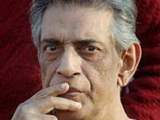Kapurush O Mahapurush (The Coward and the Holy Man)
Amitabh, a scriptwriter of commercial films, drives in the country, scouting for locations. When his vehicle breaks down, he is taken in by a tea planter whose wife is Karuna, a woman whom he had formerly loved but whom he was unable or unwilling to take care of. In those days he was a poor student, uncomfortable with his involvement with this woman from a well-off family; just as she had made up her mind to accept his situation and bravely confront her family's disapproval, he left her. Now that he has become successful on his own, Amitabh would love for Karuna to leave her husband and live with him. He arranges a rendezvous at the train station.
Nayak
When all the flights are booked, Arindan, a star of Bengali films, is forced to take the train from Calcutta to New Delhi in order to receive an award. Habituated to admiring crowds around him it is a young journalist, Aditi, who engages his attention. Lucidly, and critical of the function of a star, she interrogates him and compels him to re-examine his life. Through the bond that develops between them, the hero reviews his actor's life, his moments of strength and moments of crisis, and is again stricken by doubt. In the end, the journalist chooses to suppress the confidences he has revealed in order to allow him to preserve his public image.
Chiriakhana
Ray made this film, like Abhijaan before this to his assistants who conceived of the initial idea. He had almost no input in the choice of the story and casting. However he agreed to direct the film when the producers insisted on inclusion of Ray himself.
The director of a retirement home calls in a private detective, Byomkesh, to investigate one of his residents, a former film star. While delivering some new information on the phone, the director is assassinated. A witness, a deaf-mute, is a witness. He is killed in turn when he writes down what he has seen.
Ray, though pleased with the final result, was aware that "the vital clue is a matter of semantics which is untranslatable". In addition he thoufg it might be too subtle and introspective for the wider audiences. "Certainly not for Bond-addicts!" he said. Therefore it is not surprising that few have seen this film outside Bengal.
Goopy Gyne Bagha Byne
The action occurs in an imaginary land. Goopy the singer and Bagha the drummer are untalented musicians whose playing provokes as much ridicule from the peasants as it does contempt from the king. The only audience they manage to charm is the ghosts. Wearing magic sandals, they arrive in the kingdom of Shundi where, to everyone's amazement, the ruler admires their music. Meanwhile, the king of the neighboring realm of Halla, who is the twin brother of the king of Shundi, wants to declare war. Goopy and Bagha do everything in their power to dissuade him, and finally it is their singing that demobilizes the troops at the last moment. Reconciled, the twin brothers offer to reward Goopy and Bagha with their daughters in marriage.
Aranyer Din Ratri
Four friends from Calcutta who have very different personalities make a holiday excursion into the country, to a tiny village in the state of Bihar where they set themselves up in a bungalow. A series of minor events, all connected to their respective reactions to their new environment, reveals their characters more deeply. Displaced from their customary sense of social rules, they engage Lakha as a servant until the day when Hari, having lost his wallet, accuses him of stealing it, strikes him, and sends him away. They meet a beautiful local woman, Duli. When Hari uses for some fast sex, Lakha ambushes him in revenge. The others become very friendly with two young women from the neighborhood who live on a comfortable estate. The inhibited Sanjoy does not dare to respond to Jaya's interest while Aparna leaves Asim after giving him her address on a five-rupee note. The friends depart again for the city, pretending to be unaffected by their experiences.
Referred to as 'Ray's Mozartian masterpeice' for its emotional complexity and delicate balancing of responses, this film proves, definitively, Ray's affinity with Mozart. The original negative of this film was lost in a film fire.
Pratidwandi (The Adversary)
Sidhartha, a medical student, feels he must discontinue his studies following the death of his father. He looks for a job and has to submit to a formal interviews requiring that the candidate be examined by a committee on questions of general culture. He realizes that he lacks the all important element of backing. Somewhat mentally disoriented, wandering in a Calcutta shocked by intense political upheaval and revolutionary violence, he ends by accepting a medical sales position, away from the city and the girl he loves.
Seema Baddha
Syamal, sales director of an English firm in Calcutta which manufactures ventilators, aspires to win the job of company director but must compete with a colleague who is manoeuvering to get the position for himself. His sister-in-law Sudarsana arrives to spend a few days with them. She remembers having been jealous of her sister's marriage, something Syamal appears not to have forgotten. In order to cover up his company's problems meeting a production deadline, Syamal resorts to provoking a strike at the factory and, in the end, obtains the coveted directorship. His machinations are observed by Sudarsana who, unlike her sister, gains clear insight into the personality of her brother-in-law.
Ashani Sanket
The action, which occurs in a tiny village in 1943, during World War II, is based on the man-made famine that caused the deaths of five million inhabitants of Colonial Bengal.
Gangacharan, a Brahmin recently settled in the village with his wife Ananga, decides to start a school in exchange for being supported by the villagers. Airplanes disturb the peaceful sky, a metaphor for the disruption of traditional life of the villagers by War in Europe. It causes the price of rice to increase rapidly. This causes hardship for and rioting by the villagers and hording of grain by merchants. Gangacharan, shrewd, manages to initially, keep himself supplied with food in exchange for his services. However conditions begin to deteriorate rapidly. Anaga is molested while hunting for edible roots in the lush forest, highlighting the irony of the situation : there is no drought and the fields have produced a good harvest that season. The film ends with Anaga telling Ganga about her pregnency as a deluge of starving humanity approaches toward them.
Sonar Kella
A parapsychologist discovers that the drawings of the child Mukul represent scenes from a former life. It emerges that everything had taken place in a fortress, where the boy's father had worked as a gem cutter. The child is led to places in Rajastan where such an environment might be found. Alerted to this strange phenomenon by newspaper reports, some bandits kidnap the boy. The detective Feluda is engaged, along with his assistant Tapesh, to recover the child.
Jana Aranya
Somnath, a student, ends up absurdly failing his exams when the grader, without his glasses, is unable to decipher his miniscule writing. He gives up his studies, looks for a job, and decides to launch himself on a career in business. He becomes an independent salesman, paid on commission, to the great despair of his father, a descendant of a noble caste who considers engaging in commerce to be supremely disgraceful to the family reputation. As part of his business dealings, Somnath discovers the expedient value of corrupt practices. After lengthy hesitation, he agrees to provide a prostitute who is none other than the sister of his best friend from school in order to obtain a contract. He says nothing about all this to his father, who may to some extent only be pretending to be ignorant of what is being concealed from him.
Shatranj Ke Khiladi
The action takes place in 1856, in Lucknow, capital of the moslem kingdom of Oudh. The king Wajid Ali Shah, who prefers to devote himself to the pleasures of art instead of submitting to the subterfuges and stakes of politics. He dedicates his time, sequestered in his palace, to poetry and to recitals of music and dance. The English Company of India, which is strengthening its grip on the country (in 1858 the British crown would directly take over control of the government), charges general Outtram with dethroning the king, who eventually abdicates without a fight. Parallel to this, two aristocrats ravenously indulge their passion for chess while neglecting everything else, beginning with their respective wives. We first see them playing chess in their houses, and they end up playing outdoors, without having noticed the historic changes ocurring under their noses.
Edited by Qwest - 18 years ago

















comment:
p_commentcount